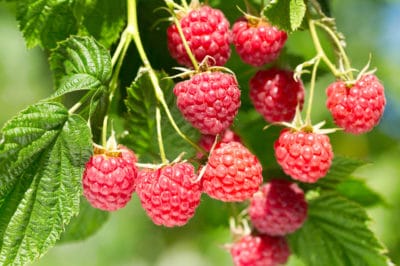Fertilizing
A good start in the right soil is a crucial step to caring for raspberry plants. Canes should be planted in a well-drained composted soil with added fertilizer in the spring or summer (for some types of raspberries).
At planting time, mix in an organic fertilizer like bone meal, blood meal, or fish. Two handfuls of the powdered fertilizer per square yard are enough to supply adequate nitrogen. Mix the fertilizer within the top 2 inches of the soil. Fertilizing once every spring when the canes begin to grow is all that is needed for raspberry bushes.
Proper Watering
There are raspberry varieties bred for USDA Zones 3-11. The water needs vary greatly in these zones. If an area does not get the proper amount of rain, watering with a hose will be necessary. Here are some guidelines for proper watering:
- Soil around the bush should be well watered but not soggy.
- A soaker hose watering for one to two hours once a week may be all that is needed.
- Water more during dry periods to prevent berries from drying out.
- Do not overhead water. This promotes leaf diseases and fruit rot.
- Water whenever the top of the soil begins drying out.
Trellis Support
Raspberries vines grow as tall as 7 to 9 feet and should be grown on a trellis. The benefits of trellis grown raspberries are these: larger crops, disease prevention, easier picking, better quality of fruit, better air circulation, and better sun exposure.
Raspberries are usually grown in either the hill system or hedgerow system. The type of trellis used depends on the system used. Here are some types of trellises:
- T-Trellis
- V-Trellis
- California V-Trellis
- Shift Trellis
Pruning
Proper pruning is vital to the quantity and quality of raspberries. The steps of pruning vary with the variety and type of raspberry planted. Pruning of the old canes is done for all types usually once a year: some need a second or third pruning. Narrowing hedgerows every season is also important.
Harvesting
After raspberries begin to ripen, picking should be done every three to four days. Picking should only be done when the berries are dry. Carefully pick only the darkest berries. Place the berries in the refrigerator immediately. Berries perish quickly. Eat or preserve the berries as soon as possible.
